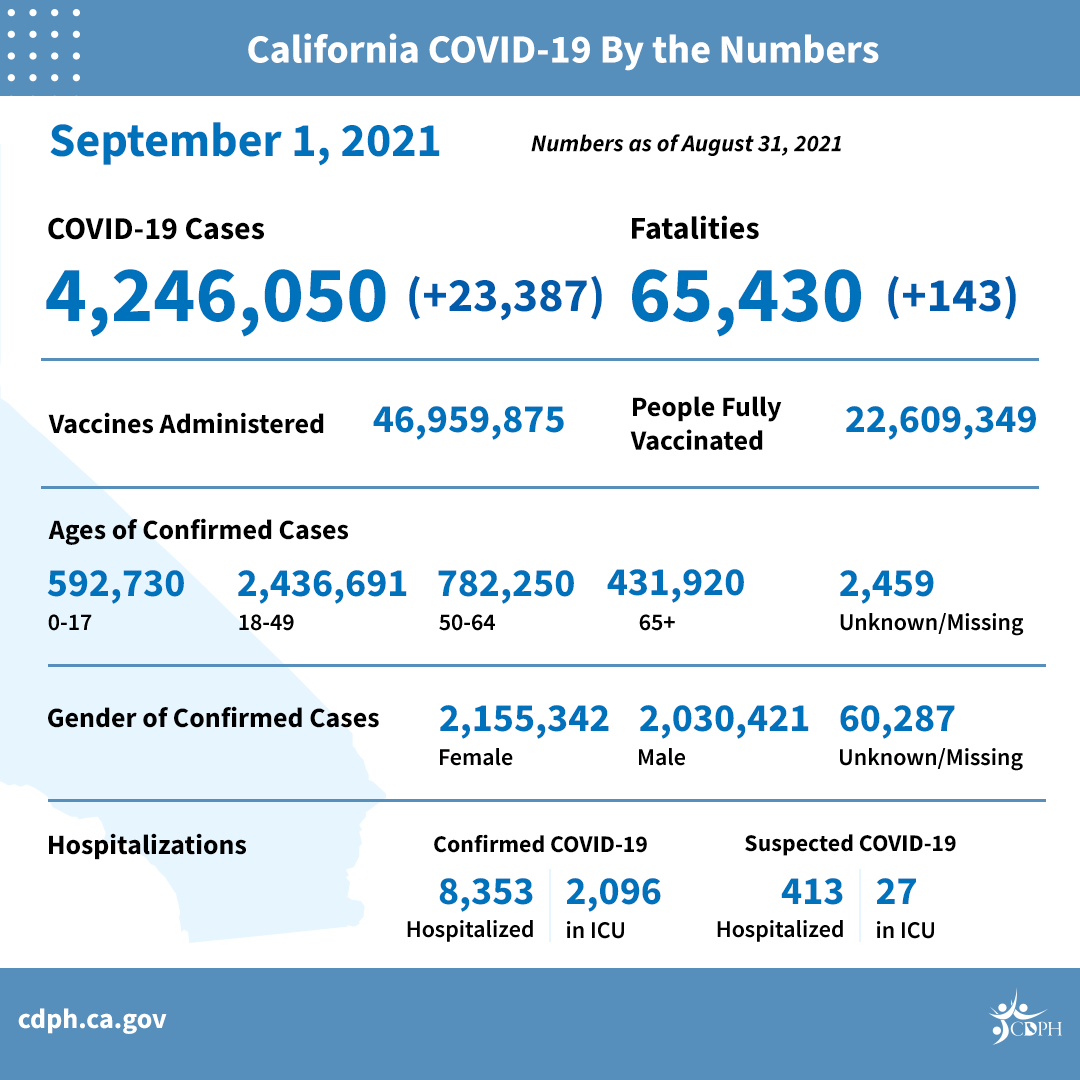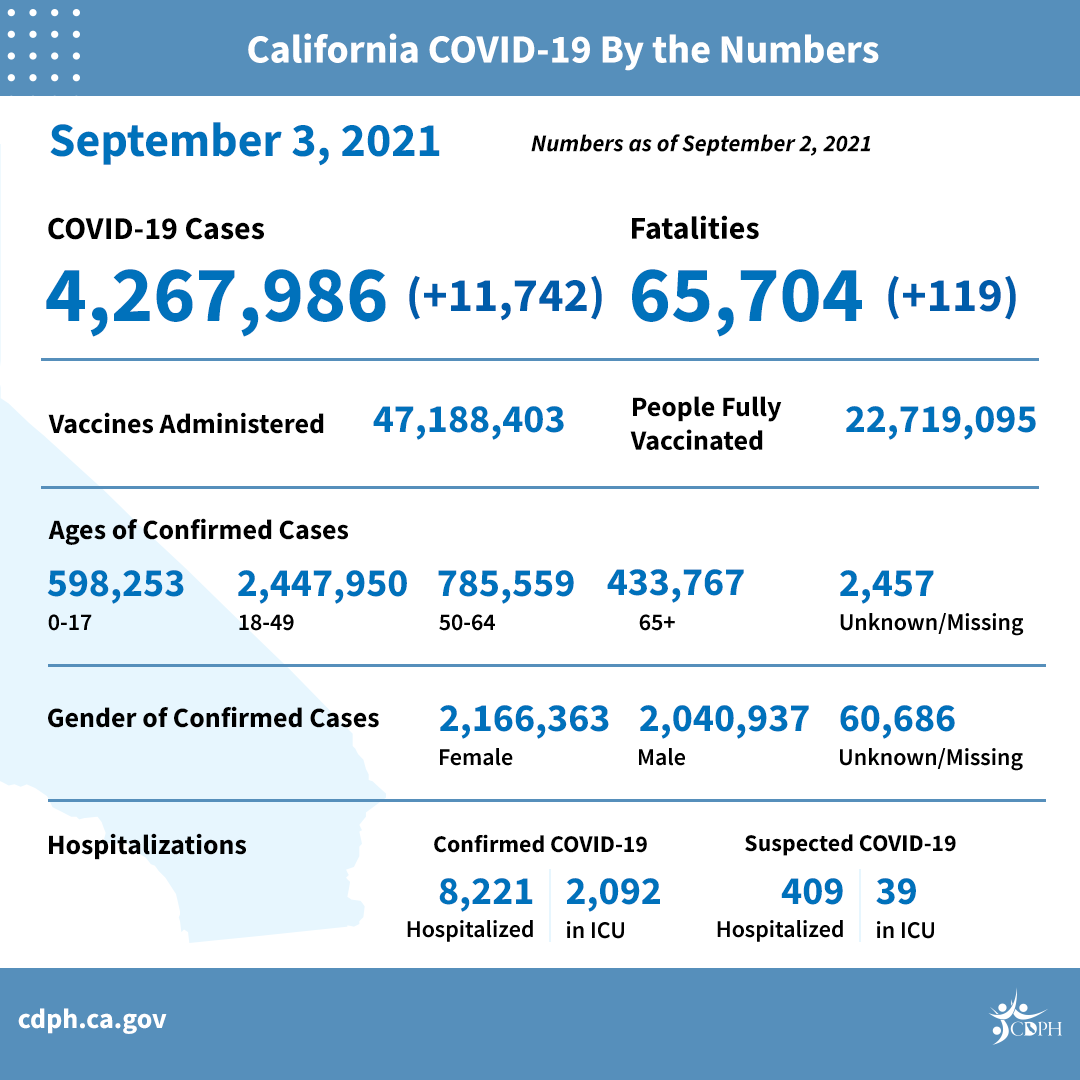Date: September 3, 2021
Number: NR21-269
Contact: CDPHpress@cdph.ca.gov
ICU Capacity in San Joaquin Valley Region Triggers Hospital Surge Order
SACRAMENTO – Today, the California Department of Public Health (CDPH) released the most recent statistics on COVID-19 and updates on the state's pandemic response.
San Joaquin Valley Region ICU Capacity
In accordance with the Public Health Order on Hospital and Health Care System Surge, the California Department of Public Health (CDPH) publishes regional and statewide ICU capacity data on its website daily.
The San Joaquin Valley Region has met the threshold to enter surge protocols. It is the first region in the state to trigger the Public Health Order. Counties within the region include: Calaveras, Fresno, Kern, Kings, Madera, Mariposa, Merced, San Benito, San Joaquin, Stanislaus, Tulare, and Tuolumne.
The regional threshold is triggered when a region has less than 10% of staffed adult ICU beds available for a period of three consecutive days. For at least the next seven days, hospitals in the San Joaquin Valley Region must adhere to the following:
- All general acute care hospitals in the county who do have ICU bed capacity must accept transfer patients when clinically appropriate and directed by the Medical and Health Operational Area Coordinator (MHOAC).
- All general acute care hospitals in the region who do have ICU bed capacity must accept transfer patients when clinically appropriate and directed by the Regional Disaster Medical Health Specialist (RDMHS).
- If there is no ICU bed capacity within the region, then all general acute care hospital in the State of California must accept transfer patients when clinically appropriate and directed by the California Emergency Medical Services Authority (EMSA) Director or designee.
The state has learned from previous increases in COVID-19 cases and hospitalizations that coordination at the local, regional, and statewide level is the best course of action. While the state works to further increase the number of eligible Californians vaccinated, we must take steps to protect the unvaccinated who are more at risk of severe illness, hospitalization and death from COVID-19. This action will ensure the state's health care delivery system is prepared and can respond appropriately.
The San Joaquin Valley Region will be reevaluated on September 9.
Statewide COVID-19 Data as of Today
- California has 4,267,986 confirmed cases to date. Numbers may not represent true day-over-day change as reporting of test results can be delayed.
- There were 11,742 newly reported confirmed cases Thursday.
- Cases are increasing statewide, largely among unvaccinated populations.
- For the week of August 15 – August 21, the average case rate among unvaccinated Californians age 16 or older is 61.55 per 100,000 per day and the average case rate among vaccinated Californians age 16 or older is significantly lower at 10.77 per 100,000 per day.
- The vast majority of new cases are among the unvaccinated with 571% higher case rates among the unvaccinated than for those who are vaccinated.
- The 7-day positivity rate is 4.9%.
- There have been 83,316,120 tests conducted in California. This represents an increase of 343,646 during the prior 24-hour reporting period.
- There have been 65,074 COVID-19 deaths since the start of the pandemic.
- As of September 2, according to the CDC, 80.9% of eligible Californians have received at least one dose. Providers have reported to CDPH that a total of 47,188,403 vaccine doses have been administered statewide. Numbers do not represent true day-to-day change as reporting may be delayed. For more vaccination data, visit the COVID-19 Vaccine Data Dashboard.


ADDITIONAL DATA & UPDATES
Tracking COVID-19 in California
Stop the Spread: Get Vaccinated for COVID-19
The risk for COVID-19 exposure and infection continues as a number of Californians remain unvaccinated. With the emergence of the more transmissible Delta variant, there is a renewed urgency to get all eligible Californians vaccinated as quickly as possible and complete their two-dose vaccination process if they are receiving Pfizer or Moderna.
The COVID-19 vaccine is safe, free and provides excellent protection from severe COVID-19 illness, including the Delta variant, hospitalization, and death.
Vaccination appointments for individuals aged 12+ can be made by visiting myturn.ca.gov. The consent of a parent or legal guardian may be needed for those between the ages of 12 and 17 to receive a vaccination. Visit Vaccinate All 58 to learn more about the safe and effective vaccines available.
Health Care Workers
As of September 2, local health departments have reported 121,920 confirmed positive cases in health care workers and 494 deaths statewide.
Testing Turnaround Time
The testing turnaround time dashboard reports how long California patients are waiting for COVID-19 test results. During the week of August 22 to August 28, the average time patients waited for test results was 1.3 days. During this same time period, 64% of patients received test results in one day and 88% received them within two days.
Multisystem Inflammatory Syndrome in Children (MIS-C)
As of August 30, there have been 592 cases of Multisystem Inflammatory Syndrome in Children (MIS-C) reported statewide (-4 from San Diego due to removal of duplications.) MIS-C is a rare inflammatory condition associated with COVID-19 that can damage multiple organ systems. MIS-C can require hospitalization and be life threatening.
Keep California Healthy
Protect yourself, family, friends and your community by following these prevention measures:
- Get vaccinated, it's your turn now! Californians age 12+ are eligible to make appointments or go to a walk-in site for vaccination.
- If you are experiencing symptoms of COVID-19 (fever, cough, shortness of breath, fatigue, muscle or body aches), call your health care provider.
- If you believe you have been exposed, get tested. Free, confidential testing is available statewide.
- Wear a mask when required. Read the latest face covering guidance.
- Wash hands with soap and water for at least 20 seconds.
- Delay travel (both domestic and international) until you are fully vaccinated. Read the CDC's full travel guidance.
- Avoid close contact with people who are sick and stay home from work and school if you feel ill.
- Add your phone to the fight by signing up for COVID-19 exposure notifications from CA Notify.
- Answer the call or text if a contact tracer from the CA COVID Team or your local health department tries to connect.